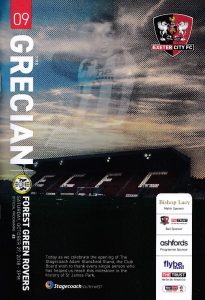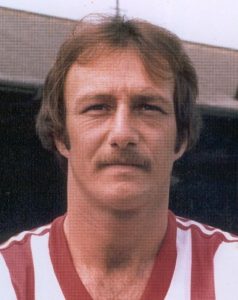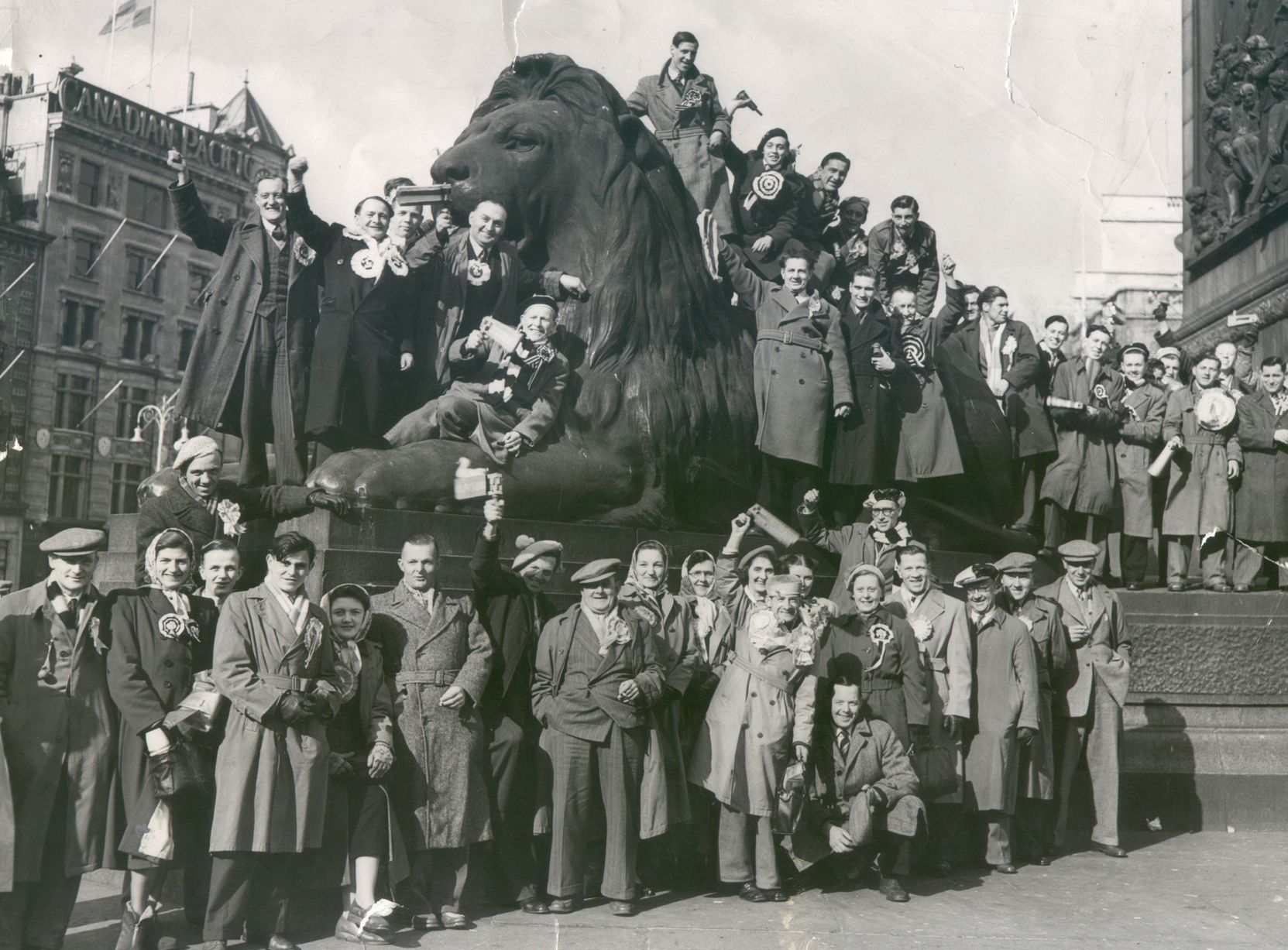Exeter City 1 Forest Green Rovers 2
League 2
Saturday 27 October 2018

making a stand
The context
One off John’s list but certainly not mine. My Mum’s family lived on Sidwell Street and attended St Sidwell’s Church, where City were formed in 1904; even after forty-plus years away I still sometimes feel a twitch upon the thread. Shane MacGowan surely spoke for exiled Devonians when he wrote “Wherever we go we celebrate/the land that makes us refugees.”
The history
Exeter controls all routes south. Roman invaders recognised a dominant position below the high ground of Dartmoor and Exmoor; Norman occupiers built their cathedral to control Bishop Leofric’s religious settlement, Civil War troops from both sides squabbled over it. Ten decades’ cultural and architectural significance would later be spitefully destroyed by Hitler’s Luftwaffe in just two murderous nights during May 1942.
Tourism helped grow Devon’s railways. Humble fishing villages – Dawlish, Torquay, Paignton – cultivated palm trees and started calling themselves the English Riviera. Exeter’s first station was built by Isambard Kingdom Brunel beneath St David’s Hill. By 1877 through trains had connected London with Plymouth via Bristol, with new branch lines serving Barnstaple and Okehampton.
Passengers could also travel to Waterloo from a second new station at Queen Street. Local services departed from there for Exmouth’s seaside attractions; substantial locomotive sheds once stood where these two lines diverged (Morrison’s Stoke Hill supermarket now partly covers the site). Queen Street – connected with St David’s by steep, curving tracks – was later renamed Exeter Central.
Various small halts dotted Exeter’s suburbs. Some, such as Mount Pleasant and Whipton, failed to attract sufficient trade and have long gone. Lion’s Holt Halt (yes, I know) remains one notable survivor. Due to its convenient location beside the home ground of newly-formed Exeter City this soon became popular with matchgoers, and was renamed St James Park in 1946.
Trains must have been busy on 4 March 1931 when City attracted more than 21,000 to their FA Cup quarter-final replay with Sunderland. This crowd has never been bettered, although 1950s Cup-ties against Luton and Chelsea came close. League visits by Plymouth regularly attracted 20,000-plus gates during the same era; another capacity crowd saw European Cup holders Manchester United win 3-1 here in 1969.
St James Park’s smart new main stand would be used for the first time today. Several hundred fans were trying out its modern facilities, and you could sense palpable excitement among ever-helpful Supporters Trust volunteers standing about with information packs. One gentleman became positively misty-eyed on hearing that 1980-81 had been my last regular season. “We had a good Cup run that year”, he said.
Three post-War Exeter sides enjoy legendary status. Most recent is the Conference team who drew 0-0 at Old Trafford and took Manchester United to a replay, paying off all City’s debts at a stroke. Many remember Terry Cooper’s Division Four champions from 1990 with equal fondness. But for many of us the raw, unexpected excitement of 1980-81 will never be bettered.
City had been promoted to Division Three in 1977. When popular manager Bobby Saxton decamped to Plymouth he was succeeded by Bath City’s shrewd, abrasive Brian Godfrey. Former Welsh international Godfrey would achieve three successive top-half finishes. An inspired move saw him bring old favourite Tony Kellow back from Blackpool during the summer of 1980, and Kellow responded by scoring 33 goals.
The FA Cup first round saw non-League Leatherhead – themselves notable giantkillers -beaten 5-0. From then on City were only drawn away from home. Goalkeeper Len Bond played well at Millwall, where Peter Rogers scored the only goal; then, a 4-2 away win against another non-League side, Maidstone United, set up their fourth round trip to First Division Leicester City.
Exeter should have lost at Filbert Street. They scarcely touched the ball before half time, but grew more confident following Dave Pullar’s unexpected equaliser. The replay saw over 15,000 pack St James Park; Kellow scored three times, his second a slightly fortunate penalty following Andy Peake’s clumsy challenge on Rogers.
Click here to see the highlights.
Fifth Round opponents Newcastle dominated for long spells. Bond brilliantly denied Ray Clarke, and John Delve cleared off the line before Alan Shoulder’s second half opener. Once more, though, Exeter managed to equalise. Defender Lee Roberts got their goal five minutes from time when he bravely converted a long Peter Hatch throw, knocking himself out in the process.
Diehard fans began queuing for replay tickets as soon as they got back to Exeter. There can be little doubt that far more than the official gate of 17,668 crammed into St James Park four days later. Many had already been waiting five hours by the time turnstiles opened at 4.30, while hastily-erected scaffolding behind the Big Bank terrace gave some attendees an enviable – if somewhat precarious – view.
They saw City produce high-tempo football that simply brushed Newcastle aside. Hatch was involved in all four goals. First visiting ‘keeper Kevin Carr fumbled his inswinging corner over the line, next another long throw set up Ian Pearson’s acrobatic volley. It was all over before half time when he cut-back for Rogers (played onside by the injured Kenny Wharton) to side-foot a third. Two more throws – one long, another short – then preceded cousin Martyn Rogers’ final coffin nail.
Tottenham away from home always felt like one game too far. The team initially competed well despite tricky conditions, with Kellow and Peter Rogers missing half chances. But everything changed after Pearson’s departure with concussion. Glenn Hoddle – who he had been marking – laid on both Spurs goals from set pieces; Bond’s uncharacteristic fumble for Paul Miler’s decisive tap-in unfortunately remains the afternoon’s prevailing memory.
The journey
Any land near Exeter’s city centre is prime real estate. The Supporters’ Trust – owners of City since 2003, whose members can be seen on matchdays carrying out litter-picking duties among equally unglamorous tasks – deserve credit for preserving their historic but undoubtedly valuable home. Driving there, however, felt ill-advised at best. So we parked at Digby & Sowton station and caught a train up the Exmouth branch instead.
The ground
St James’ Park has always comprised four distinct sections. Their historical names – Big Bank, Cowshed, Grandstand and St James’ Road – are still used. Little changed between 1932, when its original 1925 Cowshed roof gained two extensions, and a raft of Taylor Report-inspired modifications two decades ago. I find this continuity rather comforting.
Exeter’s traditional away end was a narrow concrete wedge with awkwardly positioned entry gates. Fans on this claustrophobic terrace occasionally suffered from crushing, and each new incident led to capacity being further reduced. We found it undergoing yet another reconfiguration involving two prefabricated covers acquired from The Hive at Barnet.
You can read more about the old Cowshed here . It was replaced in 2001 by a far less bovine seated stand. Today’s reprofiled and enlarged Bank is now Britain’s biggest terrace; that distinction does, however, feel somewhat overstated. Way more people packed the old open mound against Sunderland, Manchester United and Newcastle than would ever be permitted now.
I felt excited but also slightly nervous about the rebuilt Grandstand. City’s old stand – perching precariously above Well Street and looming over that deep railway embankment – had always had been shabbily characterful. Many matchdays started and finished on a famously overgrown track, known as the Jungle Path, that sloped uphill behind ramshackle turnstiles. What if its timeless charm had been spoiled?
My fears proved unfounded. The Adam Stansfield Stand is briskly functional, but – aided by sympathetic exterior decoration – merges effortlessly with its surroundings, A modestly preserved entrance leads you onto the tamed and concreted Jungle Path, where painted murals of notable former players confirm that this special club still cares deeply about both past and future.
Flesh and wine
Once rough and ready pubs on Blackboy Road now seem petrified by creeping gentrification. Chasing hipster custom clearly hadn’t worked very well for the Horse & Dray, which was shut. After rattling around in a half-empty Bowling Green we finally made for the more traditional Duke of York. This corner pub has long been regarded as slightly edgy, but its clearly embattled – yet cheerfully boozy – clientele at least recalls the proud working-class city Exeter used to be.
Sidwell Street has always been Exeter’s very own Aya Napia. Assorted curry booths and kebab houses sadly didn’t open on Saturday afternoons, so I set off in search of pasties. Fanzones aren’t for us; a burger stall just inside was rammed, but – seeing people wandering past with pies – we soon sniffed out another, more secluded outlet hidden away down the Jungle Path.
The game
Any match against opposition whose fans drink cider counts as a derby round here. Despite this added frisson Exeter locals didn’t seem particularly energised by the sight of Forest Green’s 200-odd travelling army. Matters were hardly helped by forty-five turgid opening minutes; the only momentary distraction was Nicky Law hitting home ‘keeper James Hamon’s crossbar.
Things came briefly to life after half time when Forest Green scored two stonking goals. Reece Brown curled delicately over Hamon and in off the far post, Liam Shephard’s confident cross-shot beat him from a similar angle. Game over. There just remained one late moment of high comedy as Robert Sanchez in the Forest Green goal spilled Aaron Martin’s hopeful forty-yard punt and fumbled it into his own net like a greased piglet.
Teams and goals
Exeter: Hamon, Sweeney, Martin, Croll, Moxey, Taylor, Tillson (Jay 54), Law (Woodman 80), Martin, Forte (Abrahams 65), Stockley. Unused subs: O’Shea, Oates, Weale, Collins.
Forest Green: Sanchez, Shephard, Gunning, McGinley, Mills, Digby, James, Winchester (Collins 91), Brown, Campbell, Grubb (Archibald 74). Unused subs: Williams, Montgomery, Pearce, Worthington, Morris.
Goals: Exeter: Martin 94. Forest Green: Brown 50, Shephard 72.
Attendance: 4,983
























